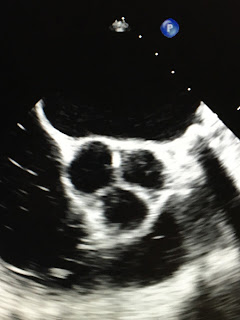The aortic valve is a three-leaflet valve situated between the left ventricle (the main pumping chamber of the heart) and the aorta (the main artery leading from the heart). When the left ventricle contracts to send blood to the body, the aortic valve opens to allow the blood to flow out. After the blood is ejected, the valve closes to prevent blood from leaking back in to the heart. The aortic valve opens and closes, under a tremendous amount of pressure, with each heartbeat, for our entire lives. Because of this, the aortic valve is subject to “wear and tear” over time. As the valve wears down, the leaflets become thickened and calcium is deposited to repair microtears in the valve. As the valve becomes more thickened and calcified, it doesn’t open fully, restricting the blood flow from the heart. This pathologic condition is called calcific aortic stenosis. When there is significant restriction of the blood flow, it is called severe aortic stenosis. Severe aortic stenosis may cause chest pain, passing out, congestive heart failure or sudden cardiac death. Unfortunately, once severe symptomatic aortic stenosis occurs, there is no medication to treat it. The only way to restore blood flow is to replace the valve. This is done by surgically removing and replacing the aortic valve or, more recently, the valve can be replaced without surgery by inserting a new valve through the artery in the groin (TAVR). Currently there are no medications that can prevent calcific aortic stenosis or slow its progression once it occurs. Or is there?
Calcific aortic stenosis is very common occurring in 2% of people over the age of 65 and 4% over 85 years old. It is associated with older age and shares other risk factors for atherosclerosis (blockage in the heart arteries). It has been known for some time that plasma lipids (cholesterol) are involved in the process of thickening and calcification of the aortic valve. It seems reasonable to presume that if elevated cholesterol is a risk factor that lowering cholesterol with a statin would halt the process. Many studies with statins have been performed. Unfortunately, statins do not halt the progression of severe calcific aortic stenosis. What if a statin is started before the disease is far advanced? Again, statins did not slow the progression in patients with mild aortic stenosis. So, lowering cholesterol doesn’t work. Are there other targets? One possibility is PCSK9. PCKS9 is a protein involved in the production of LDL cholesterol. In patients with heart artery disease PCSK9 inhibitors (such as Praluent or Repatha) dramatically lower LDL cholesterol and reduce the risk for heart attack and cardiac death. Recently it has been shown that patients with calcific aortic stenosis have higher levels of PCSK9. It is felt that PCSK9 plays a role in mediating aortic stenosis through inflammation and the stress responses of the cell. Do PCSK9 inhibitors slow the progression of calcific aortic stenosis? We don’t know, but future trials may give an answer. Another possible target is lipoprotein a. Lipoprotein a is an LDL like particle that is also associated with elevated risk for heart artery disease. Elevated levels of lipoprotein a have been shown to correlate with progression of calcific aortic stenosis as well. Patients with the highest level of lipoprotein a were twice as likely to need aortic valve replacement as patients with low levels of the protein. Statins do not lower levels of lipoprotein a, but PCSK9 inhibitors do. Whether this translates to a beneficial effect for calcific aortic stenosis is not known, but it seems a trial with these agents is badly needed.
Another potential target is cardiac amyloid. What is amyloidosis? The pathogenesis of amyloid involves a protein called TTR which is produced by the liver and aids in transporting thyroid hormone. In some people (older patients, patients with genetic predisposition), TTR clumps together to form amyloid fibrils. These amyloid fibrils are deposited in many tissues in the body, but especially the brain, the nerves and the heart. Amyloid deposition in the heart can cause a variety of problems including congestive heart failure as well as calcific aortic stenosis. In patients older than 75 years old with aortic stenosis, 14% have cardiac amyloid. Cardiac amyloid is treated with a medication called Tafamidis, which stabilizes TTR and prevents the formation of amyloid fibrils. Tafamidis slows the progression of cardiac amyloid in patients with congestive heart failure, but it is not known whether it does the same for calcific aortic stenosis. This too may be a promising area and ripe for future research.
Another potential target is calcium. Since calcium is deposited in the aortic valve do calcium supplements increase the risk? A study of 2600 patients with mild to moderate aortic stenosis found the following. Aortic valve replacement was ultimately needed in 50% of patients taking calcium supplements versus only 11% in patients not taking supplements. It was concluded that long-term calcium supplementation should be avoided in calcific aortic stenosis.
If you have calcific aortic stenosis, don’t despair. A newer and better treatment (TAVR) has already dramatically changed the life for many a patient with this disease. Although we currently cannot stop calcific aortic stenosis or alter its progression, newer targets and newer treatments may be on the horizon offering similar dramatic medical options to improve the lives of patients. In the meantime, hold those calcium supplements.


No comments:
Post a Comment